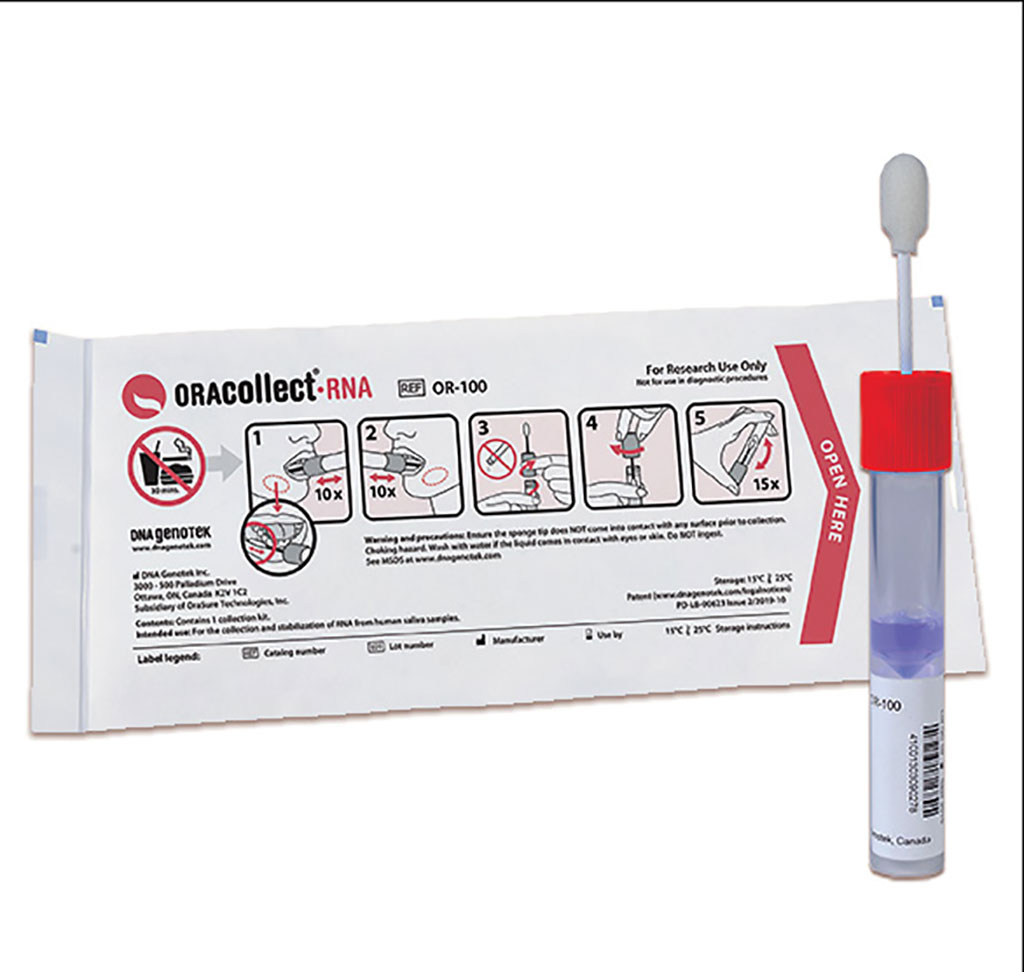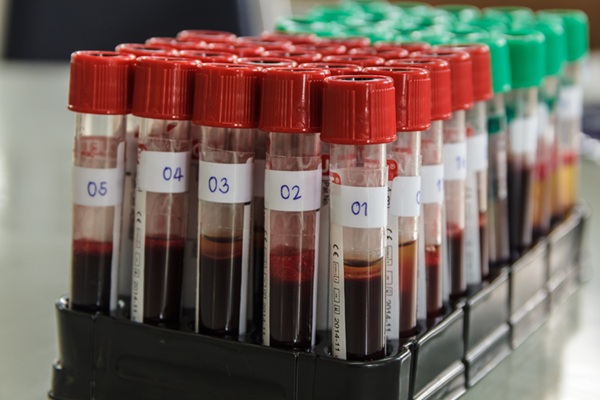ORAcollect RNA Saliva Collection Device for SARS CoV-2 Granted FDA Emergency Use Authorization
|
By LabMedica International staff writers Posted on 04 Nov 2020 |

Image: The ORAcollect·RNA collection device (Photo courtesy of OraSure Technologies, Inc.)
OraSure Technologies, Inc.’s (Bethlehem, PA, USA) subsidiary, DNA Genotek, has received Emergency Use Authorization (EUA) from the US Food and Drug Administration (FDA) for the use of the ORAcollect·RNA (OR/ORE-100) saliva collection device for the collection, stabilization and transport of saliva specimens suspected of containing SARS-CoV-2 RNA.
The ORAcollect·RNA collection device is an important component of molecular/PCR tests as laboratories are able to use it as the saliva sample collection method for their COVID-19 tests. This is the second FDA EUA received by DNA Genotek for its saliva collection devices. Similar to the EUA recently obtained by DNA Genotek for its OMNIgene·ORAL (OM/OME-505), the latest EUA allows for the unsupervised use of the device at-home or in a healthcare setting when used as a component of an authorized or cleared self-collection kit. This means it can be part of a kit that is authorized under its own EUA for use by an individual to collect saliva specimens at home.
“Accessible and accurate testing programs that include a non-invasive, saliva-based collection option will be essential throughout the duration of the COVID-19 pandemic,” said Kathleen Weber, Executive Vice President, Business Unit Leader, Molecular Solutions at DNA Genotek. “This second EUA gives our customers additional non-invasive options for SARS CoV-2 sample collection. Saliva sample collection is quick, painless, non-invasive and requires less human contact both minimizing the need for PPE and reducing exposure to potentially infected patients.”
The ORAcollect·RNA collection device is an important component of molecular/PCR tests as laboratories are able to use it as the saliva sample collection method for their COVID-19 tests. This is the second FDA EUA received by DNA Genotek for its saliva collection devices. Similar to the EUA recently obtained by DNA Genotek for its OMNIgene·ORAL (OM/OME-505), the latest EUA allows for the unsupervised use of the device at-home or in a healthcare setting when used as a component of an authorized or cleared self-collection kit. This means it can be part of a kit that is authorized under its own EUA for use by an individual to collect saliva specimens at home.
“Accessible and accurate testing programs that include a non-invasive, saliva-based collection option will be essential throughout the duration of the COVID-19 pandemic,” said Kathleen Weber, Executive Vice President, Business Unit Leader, Molecular Solutions at DNA Genotek. “This second EUA gives our customers additional non-invasive options for SARS CoV-2 sample collection. Saliva sample collection is quick, painless, non-invasive and requires less human contact both minimizing the need for PPE and reducing exposure to potentially infected patients.”
Latest COVID-19 News
- New Immunosensor Paves Way to Rapid POC Testing for COVID-19 and Emerging Infectious Diseases
- Long COVID Etiologies Found in Acute Infection Blood Samples
- Novel Device Detects COVID-19 Antibodies in Five Minutes
- CRISPR-Powered COVID-19 Test Detects SARS-CoV-2 in 30 Minutes Using Gene Scissors
- Gut Microbiome Dysbiosis Linked to COVID-19
- Novel SARS CoV-2 Rapid Antigen Test Validated for Diagnostic Accuracy
- New COVID + Flu + R.S.V. Test to Help Prepare for `Tripledemic`
- AI Takes Guesswork Out Of Lateral Flow Testing
- Fastest Ever SARS-CoV-2 Antigen Test Designed for Non-Invasive COVID-19 Testing in Any Setting
- Rapid Antigen Tests Detect Omicron, Delta SARS-CoV-2 Variants
- Health Care Professionals Showed Increased Interest in POC Technologies During Pandemic, Finds Study
- Set Up Reserve Lab Capacity Now for Faster Response to Next Pandemic, Say Researchers
- Blood Test Performed During Initial Infection Predicts Long COVID Risk
- Low-Cost COVID-19 Testing Platform Combines Sensitivity of PCR and Speed of Antigen Tests
- Finger-Prick Blood Test Identifies Immunity to COVID-19
- Quick Test Kit Determines Immunity Against COVID-19 and Its Variants
Channels
Clinical Chemistry
view channel
VOCs Show Promise for Early Multi-Cancer Detection
Early cancer detection is critical to improving survival rates, but most current screening methods focus on individual cancer types and often involve invasive procedures. This makes it difficult to identify... Read more
Portable Raman Spectroscopy Offers Cost-Effective Kidney Disease Diagnosis at POC
Kidney disease is typically diagnosed through blood or urine tests, often when patients present with symptoms such as blood in urine, shortness of breath, or weight loss. While these tests are common,... Read moreMolecular Diagnostics
view channel
New Biomarker Panel to Improve Heart Failure Diagnosis in Women
Heart failure affects millions worldwide, yet many women are still misdiagnosed or diagnosed too late. Although heart failure broadly means the heart cannot pump enough blood to the body’s cells, its two... Read more
Dual Blood Biomarkers Improve ALS Diagnostic Accuracy
Diagnosing amyotrophic lateral sclerosis (ALS) remains difficult even with advanced imaging and genetic tools, especially when clinicians must distinguish it from other neurodegenerative conditions that... Read moreHematology
view channel
ADLM’s New Coagulation Testing Guidance to Improve Care for Patients on Blood Thinners
Direct oral anticoagulants (DOACs) are one of the most common types of blood thinners. Patients take them to prevent a host of complications that could arise from blood clotting, including stroke, deep... Read more
Viscoelastic Testing Could Improve Treatment of Maternal Hemorrhage
Postpartum hemorrhage, severe bleeding after childbirth, remains one of the leading causes of maternal mortality worldwide, yet many of these deaths are preventable. Standard care can be hindered by delays... Read more
Pioneering Model Measures Radiation Exposure in Blood for Precise Cancer Treatments
Scientists have long focused on protecting organs near tumors during radiotherapy, but blood — a vital, circulating tissue — has largely been excluded from dose calculations. Each blood cell passing through... Read moreImmunology
view channel
Chip Captures Cancer Cells from Blood to Help Select Right Breast Cancer Treatment
Ductal carcinoma in situ (DCIS) accounts for about a quarter of all breast cancer cases and generally carries a good prognosis. This non-invasive form of the disease may or may not become life-threatening.... Read more
Blood-Based Liquid Biopsy Model Analyzes Immunotherapy Effectiveness
Immunotherapy has revolutionized cancer care by harnessing the immune system to fight tumors, yet predicting who will benefit remains a major challenge. Many patients undergo costly and taxing treatment... Read moreMicrobiology
view channel
15-Minute Blood Test Diagnoses Life-Threatening Infections in Children
Distinguishing minor childhood illnesses from potentially life-threatening infections such as sepsis or meningitis remains a major challenge in emergency care. Traditional tests can take hours, leaving... Read more
High-Throughput Enteric Panels Detect Multiple GI Bacterial Infections from Single Stool Swab Sample
Gastrointestinal (GI) infections are among the most common causes of illness worldwide, leading to over 1.7 million deaths annually and placing a heavy burden on healthcare systems. Conventional diagnostic... Read morePathology
view channel
AI Tool Improves Accuracy of Skin Cancer Detection
Diagnosing melanoma accurately in people with darker skin remains a longstanding challenge. Many existing artificial intelligence (AI) tools detect skin cancer more reliably in lighter skin tones, often... Read more
Highly Sensitive Imaging Technique Detects Myelin Damage
Damage to myelin—the insulating layer that helps brain cells function efficiently—is a hallmark of many neurodegenerative diseases, age-related decline, and traumatic injuries. However, studying this damage... Read moreTechnology
view channel
AI Model Achieves Breakthrough Accuracy in Ovarian Cancer Detection
Early diagnosis of ovarian cancer remains one of the toughest challenges in women’s health. Traditional tools such as the Risk of Ovarian Malignancy Algorithm (ROMA) can struggle to distinguish between... Read more
Portable Biosensor Diagnoses Psychiatric Disorders Using Saliva Samples
Early diagnosis of psychiatric disorders such as depression, schizophrenia, and bipolar disorder remains one of medicine’s most pressing challenges. Current diagnostic methods rely heavily on clinical... Read more
Cell-Sorting Device Uses Electromagnetic Levitation to Precisely Direct Cell Movement
Sorting different cell types—such as cancerous versus healthy or live versus dead cells—is a critical task in biology and medicine. However, conventional methods often require labeling, chemical exposure,... Read moreIndustry
view channel
Co-Diagnostics Forms New Business Unit to Develop AI-Powered Diagnostics
Co-Diagnostics, Inc. (Salt Lake City, UT, USA) has formed a new artificial intelligence (AI) business unit to integrate the company's existing and planned AI applications into its Co-Dx Primer Ai platform.... Read more










 assay.jpg)















